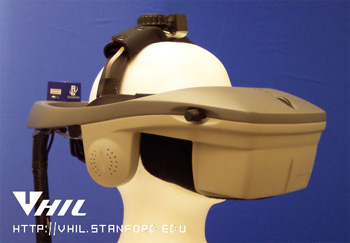I Am My Avatar
Can your avatar control how you behave? Kayvon Sharghi jumps into virtual reality to find out. Illustrated by Kelly Finan.
 |
Illustration: Kelly Finan |
Every Wednesday night, the avatar named CeNedra Rivera hosts a gathering with her friends in the online virtual community Second Life. Recently, CeNedra's event was a lingerie theme party. Cenedra's creator, "Vanessa" (not her real name), asked her girlfriends to dress their avatars—3D characters, complete with self-styled looks and personalities—in the sexiest outfits they had in their virtual closets. The next morning, when Vanessa arrived at work, she saw an image of CeNedra on her computer dressed in a sheer black teddy, stockings, a thong, and high heels. Vanessa loved how sexy her avatar looked. Then she realized something: CeNedra made her feel sexy in real life.
In the year since she joined Second Life, where people interact in virtual environments solely through their digital characters, Vanessa admits to doing things she wouldn't normally have done. She grew more social and went out on dates. Her confidence increased and she became flirty with men. On shopping trips, she tried on items that she normally wouldn't wear, but that her more adventurous digital self might. Indeed, the sexier CeNedra became in Second Life, the more confident Vanessa felt in her own skin.
Inadvertently, Vanessa was exploring a provocative question about human behavior that scientists at Stanford University's Virtual Human Interaction Lab (VHIL) have just started to address: Can a person's avatar influence their personality?
Jeremy Bailenson, the lab's director and assistant professor of communication at Stanford, thinks the answer is yes. His research suggests how you perceive yourself in a virtual environment can subconsciously carry over into the real world. Bailenson has shown that a person's behavior can change offline within minutes of immersion in a virtual environment. How this works is still unclear, but the VHIL researchers are trying to piece together theories of the underlying psychology.
Avatars 'R' Us
Avatars may be the next big thing on the Internet. By 2011, some researchers estimate, 80 percent of Internet users will have a 3D avatar participating in a virtual environment. Corporations like Toyota, Intel, and MTV have already poured cash into advertising and marketing campaigns to reach the growing number of customers in virtual realms such as Second Life. Hundreds of universities have opened virtual campuses and research centers in different online communities to test how the new medium can be used for recruiting and education.
Millions of people already spend time in virtual environments. Second Life has 9 million residents, with new users registering each day. The online game World of Warcraft is even more popular, with more than 11 million subscribers. Regular users spend an average of 22 hours online each week in these virtual communities.
At Stanford, Bailenson and his Ph.D. students are trying to determine how spending so much time online as an avatar will affect a person's behavior in real life. They use a $25,000 fully immersive head-mounted display to transport test subjects into custom-made virtual environments.
 |
| Photo: Courtesy of Virtual Human Interaction Lab, Stanford University |
Head-mounted display used at the Virtual Human Interaction Lab. |
|
|
In one recent study, Bailenson's team tested how an avatar's attractiveness influences personal behavior. Volunteers were assigned an avatar that was attractive or unattractive, then placed inside a virtual room. They were told to have their avatar look into a mirror briefly, and then interact with other avatars in the room. Just like in real life, attractive avatars were more outgoing, friendlier, and showed greater confidence than unattractive ones. The attractive avatars also engaged people at a closer distance and provided more information about themselves in conversations. Unattractive avatars behaved in the opposite way, keeping farther away from others and saying less. The results appeared in the June 2007 issue of the journal Human Communication Research.
In a follow-up study, to appear in Media Psychology, volunteers were placed in a room in real life immediately after the experiment. They were instructed to look at nine photos of people and choose two of them to ask on a date. People who had their egos stroked by having been assigned more attractive avatars chose better-looking dates than those who had been given less attractive avatars, the researchers found. The effects of embodying an avatar's qualities in real life lasted up to an hour after treatment, Bailenson says, though it's possible the feeling may last even longer.
“This explains why people with a sexy looking avatar may experience feeling sexy offline,” says Nick Yee, a former doctoral student at the VHIL and lead author of both papers.
Yee and Bailenson call this the Proteus Effect: An avatar's appearance online can trigger behavior stereotypical of that appearance offline. In CeNedra's case, the connotation of sexiness arises from seeing the photo of her avatar dressed in lingerie. “It's analogous to someone who is put into a taller avatar in a virtual world," says Yee. "They feel more confident even when they're outside the virtual world.”
More recently, Bailenson's team has shown that a person's real-life behavior can be improved by the behavior of his or her avatar. The researchers found that volunteers watching an exercising avatar that incorporates a 3D picture of their own face will exercise more and lose weight in real life. The study has implications for treating diseases such as obesity, says Bailenson, who published the work in the March 2009 issue of Media Psychology.
Virtual therapy
Some clinics already use virtual technology for behavioral therapy and treating phobias and disorders. The Virtual Reality Medical Center in San Diego, California, uses the same head-mounted displays as the Stanford researchers. The center's therapists build custom virtual environments to treat a range of problems, from fear of flying to anxiety and attention deficit disorder. Other simulations help cancer patients cope with chemotherapy-related side effects; the therapists also use virtual reality to treat returning soldiers who suffer from post-traumatic stress disorder (PTSD).
“Compared to a traditional method of therapy that employs asking questions and encouraging a patient to retell the experience over and over, virtual reality treatment is a way to immerse someone in an environment to help them talk about what they've gone through,” says research scientist Albert “Skip” Rizzo of the University of Southern California's Institute for Creative Technologies in Marina del Rey.
Rizzo specializes in developing virtual reality tools that help wartime PTSD victims. Some of the virtual environments he's created are set in the city streets of Iraq or the desert convoy roads of Afghanistan. In these environments veterans are exposed to the same sights and sounds that triggers their mind to experience a traumatic event that can then be re-framed by the therapist. Unlike online virtual communities like Second Life, extrasensory inputs such as tactile and olfactory stimuli can be added, making the experience even more immersive. The technology, Rizzo says, is not limited to any one disorder. Researchers can craft custom environments to encourage change in a given behavior.
A true Second Life
Can virtual reality also help treat victims of domestic violence? Along with depression, victims of domestic violence can experience PTSD that produces flashbacks, nightmares, anxiety, and avoidance of traumatic triggers. For women who've had abusive male partners, interacting with a member of the opposite sex can stir up painful and intrusive images of the abuse in their minds, making recovery difficult.
"Vanessa" joined Second Life because she was in an abusive relationship. When her partner was being released from prison, she created a new life online in the form of CeNedra. Many people come to Second Life for the fun of creating palace-like homes with ocean views, trying out exotic hairstyles, and flying freely like a superhero in an endless virtual sky. Vanessa joined to experience the things she struggled to do in real life, like once again trusting men and falling in love.
“There isn't a day that goes by that I don't realize how lucky I am that my son and I are alive,” she writes on her online blog, CeN's Two Cents. Although she was fortunate to escape the violent hand of her partner with only a few scars and injuries that have faded or healed, she says the psychological trauma will stay with her forever.
But for Vanessa, Second Life has offered what counseling sessions could not: a way to transition back into having normal relationships with people. “Second Life allows me to safely interact with people in ways I still can't in my first life,” she writes.
Rizzo has seen this phenomenon grow as virtual reality environments have become more convincing and immersive. The controlled settings can act as stepping-stones to help victims who suffer from traumatic events work their way back into society, he says. Interacting with male avatars using text chat in Second Life is an example of how a domestic abuse victim suffering from PTSD could gradually overcome trigger episodes, he notes.
Virtual warning signs
Although Second Life has helped Vanessa cope with her real-life trauma, she still sees the potential for abuse to happen—even without physical interaction.
When people join a virtual community, especially one as realistic as Second Life, their avatars may behave in ways they normally wouldn't in the real world. In 2007, an avatar in Second Life allegedly raped another character. Other deviant forms of behavior have been reported in "mature content" areas of the site, including child abuse and sadomasochism. Though simulated, these behaviors still bear enough resemblance to the physical world to create trauma and stress for the victims.
But you don't have to wander into fetish clubs in Second Life or have a twisted mind to inflict psychological harm on others. It can even happen unintentionally towards friends, as a Second Life avatar who goes by the pseudonym of "Juniper" points out.
Like most female avatars in Second Life, Juniper's appearance is hyper-attractive and overly sexualized. She's a tall blonde with a prominent bust who dresses in clothes emphasizing her proportions. Because she's pretty, says Juniper, her avatar gets a lot of attention from members of the opposite sex as she walks around, goes shopping, or dances at clubs.
Soon it became hard for Juniper to separate the experiences and compliments her avatar received online from who she was offline. “In real life it gave me the confidence I didn't have,” says Juniper. However, there was a darker side to her newfound self-esteem. Allowing her alter ego to bring out the worst in her online, she began disrespecting close friends in Second Life. Looking back, she says, “It caused me to hurt some people.”
Just like in real life, feelings of sadness, depression, and loneliness can easily surface online as a result of psychological abuse, relationship problems, and self-perception issues. The harm can become so severe that some people abandon their online characters—who meant so much to them for months or years—and never return.
Virtual reality now offers the full spectrum of human experiences, from positive to negative. Perhaps most notably, it can help people who have exhausted all other possibilities in real life. For Vanessa, it has offered what no amount of therapy over the years has provided: confidence. For countless others who have found their soul mates in online communities and taken that first step down the virtual aisle together, it's allowed them to begin new lives they never could have imagined for themselves.
“I do walk a little taller, I do speak up a bit more, I don't avoid attention like I used to, and I do smile a lot more. I know that much,” Vanessa writes. Although virtual reality may never heal her deepest wounds, it has nonetheless made her a happier person, online and offline.
Story © 2009 by Kayvon Sharghi. For reproduction requests, contact the Science Communication Program office.
Top
Biographies
 Kayvon Sharghi Kayvon Sharghi
B.S. (biochemistry) California Polytechnic State University, San Luis Obispo
Certificate (editing) University of Washington
Internship: National Superconducting Cyclotron Laboratory, Michigan State University, East Lansing (multimedia)
Before graduating from university with a science degree, I received the best advice of my life: “You should be a writer.” That didn't come from any adviser; it came from a Nobel laureate. The funny thing is that I was interviewing the chemistry Nobelist on camera when he said it. Nothing was mentioned of my potential to be the next Charlie Rose, but he saw in me something else I had always wanted to become.
With his encouragement, I abandoned the lab and continued my foray into multimedia. I have found that it works hand-in-hand with writing to create memorable pieces that help people understand science in a way that's impossible through words alone. So whether in written or recorded form, whether photographed or podcasted, I hope to make science a part of our lives.
. . . . . . . . . . . . . . . . . . . . . . . . . . . . . . . . . . . . . . . . . . . . . . . . . . .
 Kelly Finan Kelly Finan
B.S. (environmental science and studio art minor) Juniata College, Huntingdon, PA
Internships: Sierra Nevada Research Institute, Wawona Station, Yosemite National Park, CA, and National Aquarium, Baltimore, MD
I was a high school student visiting Juniata College when a dusty display case filled with ceramic sculptures of foraminifera, radiolarians, and other forms of microscopic life caught my eye. Propped up among the artwork was an aged piece of paper bearing the words of Dr. Arthur M. Sakler: "Art and science are two sides of the same coin. Science is a discipline pursued with passion, art is a passion pursued with discipline." I'd always avidly pursued both art and science, but it wasn't until I spotted these words that I realized how easily my interests dovetailed. I have since been unable to keep my major, environmental science, and my minor, studio art, separated. Drawing an organism improves my understanding of it, while my attention to detail as an artist develops. I'm happy to be in the Science Illustration Program, where I can take this concept and run!
Top |

